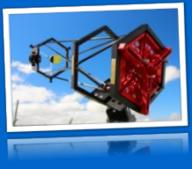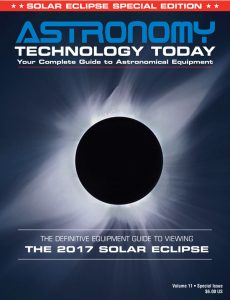Mirro-sphere’s 12-inch Serrurier-truss telescope (Image 1) represents a new concept in truss-tube design. The f/4 carbon-fiber and aluminum Newtonian is 100-percent designed and manufactured in France – mechanics and optics – to the highest specifications. It is designed for advanced amateur astronomers who want the best quality on the market.
 The idea behind this telescope was to build something different, which would perform superbly, while overcoming the shortfalls of other reflector telescopes currently on the market. The net result is that the optical elements stay in collimation, regardless of the orientation of the telescope, including passing through the meridian during imaging.
The idea behind this telescope was to build something different, which would perform superbly, while overcoming the shortfalls of other reflector telescopes currently on the market. The net result is that the optical elements stay in collimation, regardless of the orientation of the telescope, including passing through the meridian during imaging.
A design also results in a large-aperture instrument that is light enough at 18 kilograms (39.7 pounds) to be used on most mid-class EQ mounts. It also yields convenient disassembly for travel. Lightweight and rigid carbon-fiber tubes connect the headlight support rings in a Serrurier truss design, using ball screws and socket hardware.
The open-air rapid-cool-down design eliminates the need of cooling fans – the system’s inherent thermal characteristics, afforded by the freedom of air circulation around the optics, ensure that the substrates reach thermal equilibrium quickly.
Carbon-fiber tubes are used to obtain near-zero expansion of the optical tube – independent temperature focusing is achieved without the need of an extra device. All high-grade aluminum parts are powder-coated (thermoplastic coating) or receive a colored anodized surface finish.
A precision servo-motorized focuser is available on request (Image 2). It has been designed with eight shafts and four guiding columns in a configuration that ensures virtually zero slop and backlash. Two stepper motors are operated in full-step mode yielding 200 steps per revolution, providing an excellent 2.5-µm resolution coupled with 1.0 mm per revolution pitch of the threaded axle that moves the eyepiece or the camera. The motors are driven by a microcontroller coupled with a convenient hand control device. The control system is fully ASCOM compatible.
High-precision collimation of the primary mirror is achieved with three micrometric heads (Image 3), while the secondary mirror is aligned with a ball screw assembly.
###
 The Astronomy Technology Today editorial staff would like to take this opportunity to remind you of the availability of our Solar eclipse equipment guide – The Definitive Equipment Guide to the 2017 Solar Eclipse. Our goal with the 40 page publication is to provide an easy-to-consume introduction to the technological options for viewing and imaging the Great Solar Eclipse. We cover the gamut of options available including building you own solar viewer, solar glasses, smart phones, DSLR cameras, using astronomy telescopes, solar telescopes, using binoculars, solar filters (including a DYI filter option), CCD astro cameras, astro video cameras, webcams and much more. You can view the guide on our website here – its free and there is no requirement to sign up to read the guide.
The Astronomy Technology Today editorial staff would like to take this opportunity to remind you of the availability of our Solar eclipse equipment guide – The Definitive Equipment Guide to the 2017 Solar Eclipse. Our goal with the 40 page publication is to provide an easy-to-consume introduction to the technological options for viewing and imaging the Great Solar Eclipse. We cover the gamut of options available including building you own solar viewer, solar glasses, smart phones, DSLR cameras, using astronomy telescopes, solar telescopes, using binoculars, solar filters (including a DYI filter option), CCD astro cameras, astro video cameras, webcams and much more. You can view the guide on our website here – its free and there is no requirement to sign up to read the guide.

